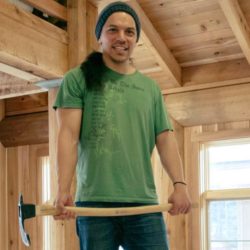
Robert Mills is a lifelong resident of Southeast, Alaska. Specifically, he calls the Tlingit Indian village of Kake his home. Robert is a Tlingit artist of the Tsaagweidi clan who works with both metal and wood. His art is deeply tied to the land of the Tlingit (the Lingit aani) and the Tlingit culture which grew out of thousands of years of interaction with this darkly-forested, fjord-riven land. Robert’s art both celebrates ancient Tlingit traditions and builds upon them.
Robert has spent roughly the last decade traveling and learning from the top Indigenous artists on the northwest Pacific coast: from the islands of Haida Gwaii in British Columbia, to the pre-American settlement of Sitka on Baranof Island, it should also be noted that while Robert has learned from many, his efforts have been entirely funded through his own hard work in multiple commercial fisheries. It is this self-reliance that has enabled him to pursue his life’s purpose as an independent artist, always informed and respectful of his deep indigenous traditions, but never slavishly subservient to them.
Whether Robert is working with metal to shape bracelets that bless the lucky wearer with a sinuous circle of beauty that also channels spiritual power; or building a totem pole that does not simply record, but also comments upon, promises broken by Amero-European colonialism; or constructing a mask depicting a fierce young shark caught in a grimace of both primal struggle and triumph, Robert is always as concerned with function as he is with form. Always as concerned with what a piece of art means, as much as he is with what it looks like.
Although finding his own way to a solution is second nature to Robert, he is no artistic island unto himself. In his art you won’t find some reckless iconoclast. While he constantly looks outward into the world, always prompted by his unceasingly curious and independent nature, Robert also deeply believes in the grounding power of Tlingit thought and culture. Land and true human identity are synonymous to Robert. The Tlingit language itself is infused with this understanding and Robert is a steadfast supporter of the resuscitation of Tlingit language and the culture it formed. This is not only for the Tlingit cultures own sake, but also as a way to help all peoples ground themselves in a more authentic understanding of our own humanity. Robert’s art: decorative, functional and testimonial, is always grounded in this truth, this earth, this Tlingit aani.
